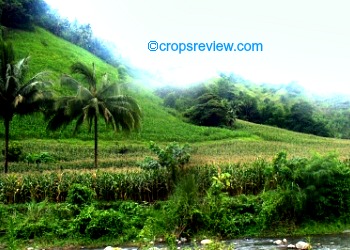On a separate page, I wrote about increased corn farming activities in our remote, mountainous part of Sarangani using no-till or zero tillage farming techniques.
Not only has the area planted to corn (maize) expanded, much of those parts of farms which have not been cultivated before or otherwise considered as hardly suitable for annual crops have, since the past few months, been converted into beautiful green landscapes of corn vegetation.
I know how hard and laborious it is to produce corn in remote places with mountainous terrain and where the only mode of transport is by foot and animal “power”.
And so it was somewhat surprising to find recently that there has been a surge in corn farming activities applying no-till farming techniques, at least in this community of marginal farmers.
Since childhood and until my teens, I helped with farming and house chores including harvesting, drying, sorting and manual shelling of corn ears, hauling of harvest by carabao-drawn sled, harvesting and cooking of young ears, and cooking of corn grains which were then our staple food.
As an adolescent I was assigned a cogonal portion in our farm (not the present one) which I cleared by slash-and-burn, tilled with the help of a carabao, and subsequently planted to an indigenous variety of corn.
It was hard work, but then rr or glyphosate-resistant corn was not yet conceived.
Corn farming is a traditional source of subsistence and livelihood for many poor farmers worldwide, particularly in rainfed rural areas.
But in highly industrialized countries and for those with sufficient capital, corn is a cash crop with versatile uses such as food, animal feed, and industrial products.
As of 2012 according to FAOSTAT, the statistics division of the Food and Agriculture Organization of the United Nations, the United States is the top producer of corn in the world with aggregate production of about 273.8 million metric tons of corn grains (maize) and 4.1 million metric tons of green corn.
In contrast, ranked 15th in the world is the Philippines with the production of about 7.4 million metric tons of corn grains which is a mere 2.7% of the U.S. production.

Corn production is ancient and the cultural practices appropriate in any community are handed down to the next generations.
Transfer of technology is by actual participation since the children of farmers customarily provide the farm labor.
Innovations and Practices in Corn Farming Practices
With the advent of glyphosate-resistant corn, rural farming communities are quick to improvise and apply no-till farming techniques.
The technology involves the use of such varieties, slash-and-burn or kaingin, chemical weed control, and post-planting application of granular fertilizers.
Undoubtedly, unless its disadvantage is convincingly proved, these farmers will continue to adopt and seek to improve this technology.
Farmers are also quick to adopt to the popularity and advantage of using glyphosate-resistant varieties.
In just a short period of time there came that open-pollinated yellow corn which is tolerant to glyphosate herbicide.
They call it “sige-sige”, a local name which connotes continuity, or perpetuality, or “always”.
A news report described it as a variety that farmers themselves bred.
Indeed, the growing of sige-sige has proliferated so much to the point that in our farming community only a few plant company-bred hybrid corn.
But still, it is apparent that corn farming activities increased in which sige-sige is the one that is predominantly grown.
No, it is not because this variety is a high yielder. It is rather because seeds are readily available at minimal cost, or even free.
Indeed, there can be a continuous free source of planting materials once able to start planting it.
Being open-pollinated, all it takes is to apply mass selection.
Whether sige-sige or any glyphosate-resistant variety, however, they still apply the same techniques in hill farming.
How these farmers actually practice no-till corn farming using these varieties in sloping lands under rainfed conditions is dealt with in separate pages on clearing and land preparation, planting, herbicide application, and fertilizer application.
The links are provided below.
Disclaimer: These series of articles are only for information purposes on farmers’ actual practices.
Herein author hereby expressly declares that he does not, and neither does this website, endorse any product or variety for farmers’ or anyone’s adoption or seek to promote negative opinion against any.
He holds that only by knowing what lies therein beyond the mountains can anyone make an informed decision.
He subscribes to the rule that everyone ought to exercise their freedom of choice.

